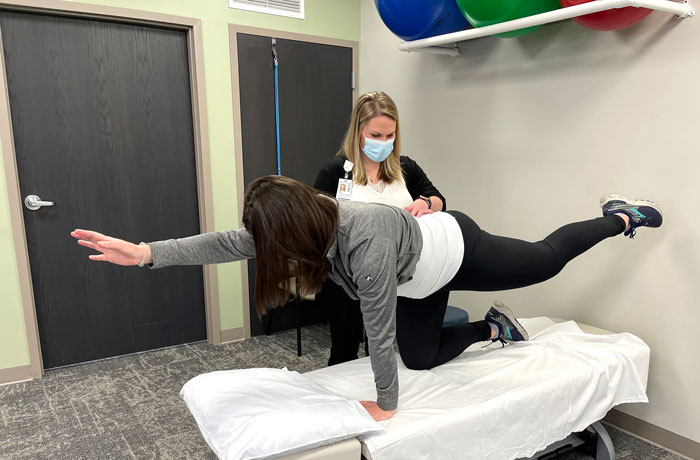
Most of us don’t think about our pelvic floors until there’s a problem, and when that happens, nobody is particularly eager to talk about it.
“Dealing with pelvic floor dysfunctions can greatly impact one’s quality of life,” said Ellen Molenaar, physical therapist, Holland Hospital Physical Therapy & Rehab Services. “Suffering from incontinence or having pain with intercourse, these are very intimate issues. While they’re difficult to talk about, it’s important for people to know that it’s more common that they might think and that treatment is available.”
Although not exclusive to females, about one-quarter of women face pelvic floor disorders. If you’re one of them, the first step toward living without pain, discomfort or the fear of accidents is talking with your health care provider. “Urinary incontinence is quite common, but shouldn’t be brushed off as acceptable or a normal part of aging,” Molenaar added. “Having the conversation may not be easy, but it’s nothing to be ashamed about. Our therapists can help.”
Your doctor or provider can pinpoint the cause of your symptoms and recommend treatments for pelvic floor dysfunction, which may include physical therapy. Available close to home at Holland Hospital, pelvic rehab goes beyond Kegel exercises. After a complete evaluation, treatments can include hands-on physical therapy techniques, education, biofeedback, electrical stimulation and exercises. Combined with lifestyle modification, these approaches can help strengthen pelvic floor muscles and alleviate pain and other symptoms.
Physical therapy for pelvic floor dysfunction can be beneficial in treating:
- Urinary or fecal incontinence (lack of urinary or bowel control)
- Pelvic organ prolapse (descending or drooping of any of the pelvic organs, such as the bladder, uterus or rectum)
- Pelvic pain
- Constipation
- Diastasis rectus abdominis (DRA; separation of the left and right sides of the outermost abdominal or stomach muscle)
Strategies that Spell Relief
To prevent or better manage pelvic floor issues, here are some strategies:
Strengthen your pelvic floor: Strengthening the muscles of the pelvic floor can help relieve or reduce uncomfortable symptoms. “First and foremost, try to perform a Kegel [attempt to stop your flow of urine]. If you can’t do this exercise, you may be a candidate for physical therapy,” Molenaar said. For optimal results, a physical therapist can help make sure you’re working the right muscles.
- Hail H2O: Drink at least six to eight glasses of H2O per day (plain water; no carbonation or flavorings).
- Take it easy: Avoid straining during bowel movements. In addition to staying hydrated with water, eat more fiber-rich foods to avoid constipation.
- Exercise: To maintain a healthy weight, establish an exercise regimen with low-impact cardio activities. “I recommend a regular walking program,” Molenaar said. “If walking is too difficult, biking or swimming are good options, too.”
- Limit leak opportunities: Steer clear of bladder-irritating foods and drinks, such as those containing caffeine and artificial sweeteners; quit smoking (cigarette smoke can irritate the bladder and chronic coughing places excess strain on pelvic floor muscles); and consider a bladder training program (emptying your bladder at regular intervals).
Holland Hospital Physical Therapy & Rehab Services offers close-to-home expertise and comprehensive support for optimal recoveries. To make an appointment, call (616) 355-3930.
